My Best Friend
 February 25th, 2020 by jules
February 25th, 2020 by jules
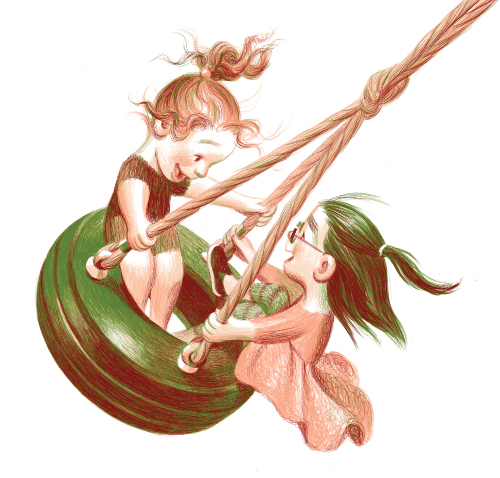
Julie Fogliano’s newest picture book, illustrated by Jillian Tamaki, is coming to shelves in early March (Atheneum). It’s called My Best Friend, and I hate to even use those initial caps in the title there, because the book has nary a capital letter in it (including in the bios on the jacket flap). The use of all lowercase letters is but one of the ways you are ushered into the world of this book, one where small people rule. Though their exuberance is anything but tiny, they are. They are preschool-aged, it’s safe to say (though they could perhaps be older toddlers). Either way, it’s two young girls, who play outdoors near what appears to be a playground.
I may as well tell you about the book’s fabulous twist ending (picture-book spoiler alert ahead) so that I can talk about it …
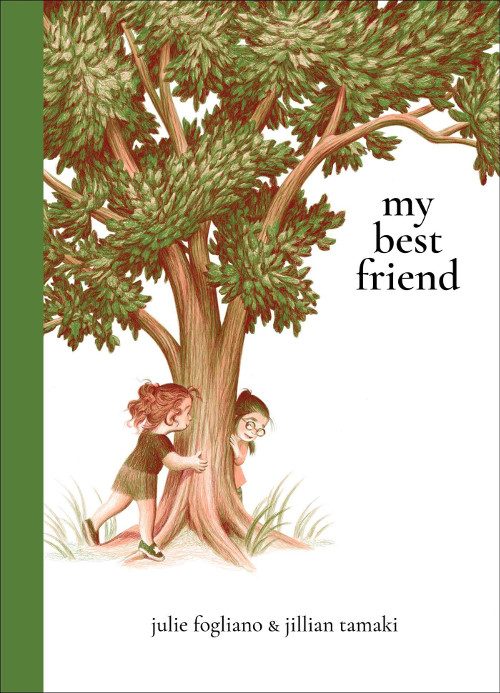
Though the book opens with “i have a new friend” — the story is told from the point of view of the red-headed girl, whose bright eyes peer out at the reader on the wordless half-title page, as if she’s just spotted us — you discover at the book’s close that the two girls have just met. All throughout the story, they play, the girl declaring this is her “best friend” and pointing out the many reasons why. Readers assume they’ve an established friendship (albeit “new,” as the narrator says immediately), but no, they part ways that day without even knowing each other’s names — and hoping they can ask each other tomorrow.

(Click spread to enlarge and read text in its entirety)
If you have ever spent any amount of time with children this age, even just the tiniest amount of time, you know this is true-to-life. The book perfectly captures the ability of young children, who — with all emotional armor down — instantly bond with a peer they’ve just met. I think of the words of the great Charlotte Zolotow, who wrote in “Making Picture Books: The Words”:
Many adults think of children as an emotionally different species from ourselves. But if there is any difference between the adult’s and the child’s feelings, it is in the greater intensity of the child’s. We adults have developed what John Donovan called our “protective coating.” Humor, irony, religion, resignation — anything to give us control and protect us from the full impact. (It can’t always work, but generally it does.) Kids don’t have those defenses yet. Their emotions are the same as those of adults, except for that one tremendous difference — children experience anger, loneliness, joy, love, sorrow, and hatred whole and plain; we, through our adult protection and veneer.
Reading the book a second time is even more delightful, knowing as you do that their day together is their very introduction to one another. Understand, the narrator speaks as if she has years of experience with her new friend, saying things like “and she always laughs at everything” or “she is so smart” or “sometimes when we are feeling quiet we sit under a big tree” or “she really likes laughing.”
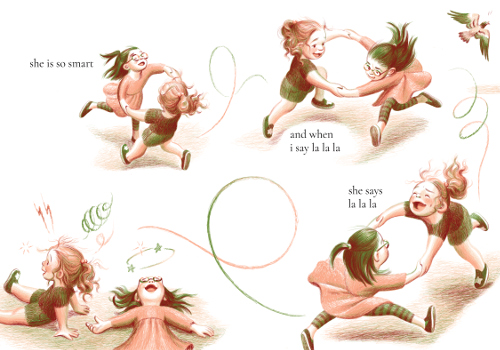
(Click spread to enlarge and read text in its entirety)
The fleeting-but-still-definitely-there uncertainty the narrator feels about their friendship is also authentic — and touching (without being saccharine, which Fogliano would never do to us). The narrator notes around the mid-way point in the book that she’s never had a best friend, so she isn’t sure, but she is fairly confident this is it. This is how it is to have found a best friend. (This is not only true-to-life for children, but unless I’m a freak, I can guarantee you adults can sometimes have these same moments of doubt.)
There’s a great deal of drama here. In just one spread, you go from extreme joy to sorrow: The narrator’s new friend chases her, as she laughs big, but the next moment she has stepped on some flowers, tears flowing. (But don’t fret, because her best friend fixes them to appear as if “we never squashed them.” This is pictured below in this post.) There’s also a lot of humor, such as when the narrator makes her friend laugh, pretending to be a pickle. (How much do I love this? A whole, whole bunch.)
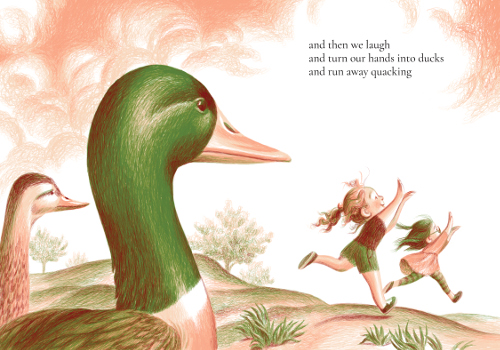
(Click spread to enlarge and read text in its entirety)
Tamaki brings readers many aerial views, even if we’re just slightly above and to the side of the girls playing. Sometimes, we are right there and soooo close to them, such as the moment they clasp their arms around one another’s necks, cementing their adoration for one another. Tamaki’s palette is dominated by cool green and rust hues; it’s a limited, and exquisite, earth-toned palette. I like how the School Library Journal review refers to these colors as “the muted hues of sunset.” There’s a lot of movement, as the girls play. There are graceful lines, as well as vividly expressive body language and facial expressions. In one of the closings spreads, things take a fanciful turn, and we see the girls riding over-sized versions of a squirrel and bird, flying through the air.
There’s a lot to love here, including the cover. Be sure to remove the dustjacket and take a peek, if you can.
Here below are a few more spreads from this splendid book so that the words and art can do the talking.
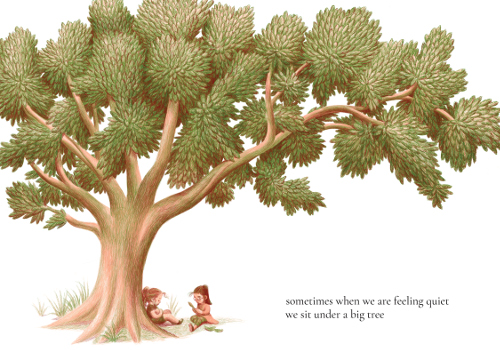
(Click spread to enlarge)
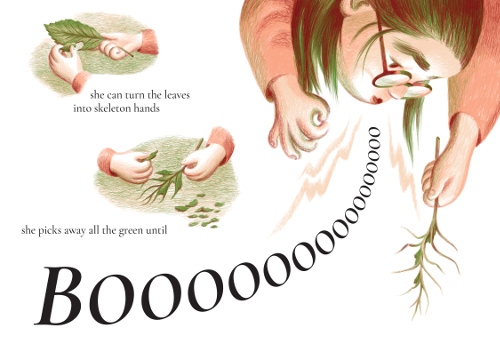
(Click spread to enlarge and read text in its entirety)

(Click spread to enlarge and read text in its entirety)
MY BEST FRIEND. Text copyright © 2020 by Julie Fogliano. Illustrations copyright © 2020 by Jillian Tamaki and reproduced by permission of the publisher, Atheneum Books for Young Readers, New York.

This sounds and looks irresistible and reminds me of my favorite early friendship story: My happy life by Rose Lagercrantz and illustrated by Eva Eriksson, and the many sequels. Lagercrantz also understands a child’s intensity and devotion and I adore this series from Sweden.
Me too, Susan! I love that series. So much.